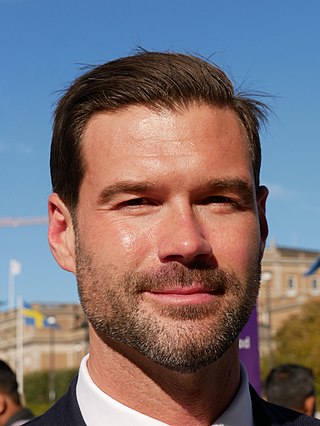
This is a list of governors for Stockholm County of Sweden. Stockholm County separated from Uppland County, the first time from 1641 to 1654, and then finally in 1719. The City of Stockholm was separately governed by the Governor of Stockholm until 1967, when it was integrated into Stockholm County. The governors reside in Tessin Palace.
The Governor of Stockholm was the head of the Office of the Governor of Stockholm, and as such he was the highest Swedish State official overseeing the affairs in the City of Stockholm between 1634 and 1967. The Governor was the equivalent in Stockholm of a county governor elsewhere in Sweden.

The Minister for Foreign Trade,, formally cabinet minister of the Ministry of Foreign Affairs, is a member and minister of the Government of Sweden and is appointed by the Prime Minister. The minister is responsible for policies related to trade and investment promotion.

Olof Immanuel Fåhræus, was a Swedish civil servant, politician and entomologist mainly interested in Coleoptera.

Oscar Broady was a petty officer in the Swedish navy who emigrated to the United States. During the Civil War he rose to the command of a brigade in the Union Army. After returning to Sweden as a Baptist missionary, he became the first president of the Swedish Baptist Bethel Seminary.
The Ministry of Communications (Transport) (Swedish: Kommunikationsdepartementet) was a ministry in Sweden, established in 1920 in connection with the division of the Ministry for Civil Service Affairs. The department dealt with administrative matters concerning, among other things, railways and tramways, post telegraph and telephone, canals, roads, bridges, ferries, air traffic, geotechnical, meteorological and hydrological surveys, radio broadcasting and electrical installations. The ministry was headed by the minister of communications (transport). In 1999, the ministry was replaced by the Ministry of Enterprise and Innovation.
The Ministry of the Interior was a ministry in Sweden established in 1947. The department dealt with matters concerning general health and medical care, the police service, the fire service, and the local government. The ministry was headed by the minister of the interior. At the end of 1973, the Ministry of the Interior ceased to exist and the activities were taken over by other ministries, such as the Ministry of Employment and the Ministry of Housing. In 1996, the former Ministry for Civil Service Affairs changed its name to the Ministry of the Interior and was called that until 1998, when the ministry ceased.

The Quartermaster-General of the Swedish Army was a general officer who was responsible for the Swedish Army Quartermaster Corps, the quartermaster branch of the Swedish Army.
The Ministry for Civil Service Affairs was a ministry in Sweden, established through the 1840 ministerial reform. The ministry and its most important areas of responsibility were agriculture, bergsrörelse, trade, shipping, factories, crafts and other industries, public roads and other communications. The ministry was headed by the minister for civil service affairs. In 1920, the Ministry for Civil Service Affairs was replaced by two ministries: the Ministry of Social Affairs and the Ministry of Communications (Transport). The Ministry for Civil Service Affairs was re-established in 1950 and then handled the wage and pension system until 1969 when it became the Ministry of Local Government. In 1983, the Ministry for Civil Service Affairs was re-established and operated until 1996, when the Ministry for Civil Service Affairs was transformed into the Ministry of Internal Affairs which was disestablished two years later.
The Ministry of Commerce and Industry was a ministry in Sweden, established in 1920 when certain matters were taken over from the Ministry of Finance. The ministry was headed by the minister of commerce and industry. The ministry ceased to exist in 1982 and matters were transferred to the Ministry for Foreign Affairs.

The Minister of Supply was a member of the government of Sweden. The minister of supply was the head of the Ministry of Supply from 1939 to 1950 which handled matters relating to the national economy.
The Ministry of Supply was a ministry in Sweden established in 1939. The ministry was established in order to provide a better overview of the crisis measures that the Second World War caused. The ministry dealt with administrative matters relating to general guidelines for government activities to ensure the supply within Sweden of necessities that were important to the population or production. The ministry was headed by the minister of supply. The ministry ceased to exist in 1950.
The Ministry of Education and Ecclesiastical Affairs was a ministry in Sweden established in 1840. The ministry dealt with matters concerning the church, education, science, culture, medical and general health care as well as poorhouses. The ministry was headed by the minister of education and ecclesiastical affairs. The ministry changed its name on 31 December 1967 to the Ministry of Education and Cultural Affairs.

The Minister of Education and Ecclesiastical Affairs was a member of the government of Sweden. The minister of education and ecclesiastical affairs was the head of the Ministry of Education and Ecclesiastical Affairs from 1840 to 1967 which handled matters concerning the church, education, science, culture, medical and general health care as well as poorhouses. The minister of education and ecclesiastical affairs became the minister for education on 1 January 1968.
The Ministry of the Budget was a ministry in Sweden established in 1976. The ministry was primarily responsible for budget regulation as well as the general administration and accounting of state funds, the state and municipal tax system. The ministry was headed by the minister for the budget. The ministry ceased to exist in 1982.
































